Symposiums in Tokyo
The Faculty of Societal Safety Sciences and the Graduate School of Societal Safety Sciences, for the purpose of improving social recognition of the faculty and graduate school and returning the research results, have been annually holding symposiums for businesses and administrative officials since AY 2010 in Tokyo.
The leading experts in various fields related to societal safety, together with the faculty members of the University, are delivering lectures, panel discussions, and/or exercises, based on the year’s theme. Also, since the third year, the research results presentations of the undergraduates of the Faculty are also presented in a panel exhibition format at the same time, in order to disseminate their research results into society. Please see the following, for the outline of each presentation.
The 8th Symposium in Tokyo
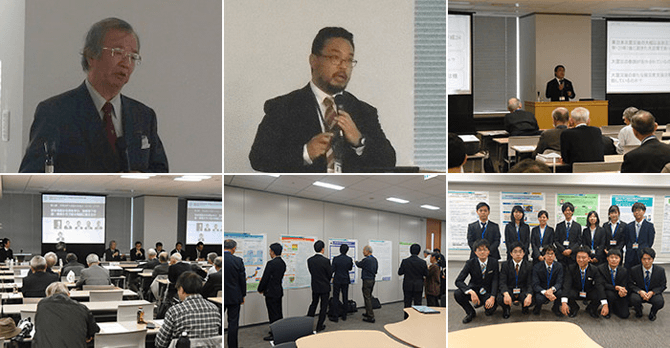
Date and time: December 1, 2017
Place: Kansai University Tokyo Center
On Friday, December 1, 2017 at the Kansai University Tokyo Center, the 8th Tokyo Symposium was held on the subject of "Be Prepared for earthquakes that directly hits Tokyo area and Nankai megathrust earthquakes! - Lessons Learned From the Kumamoto Earthquake -."
The symposium was organized in two parts, and first of all in Part 1, Yoshiaki Kawata, Specially Appointed Professor of the Faculty, delivered a keynote talk titled "Japan Will Collapse!" Explanations were given on the relevance between the major disasters that have occurred in the history of Japan (Simultaneous the earthquakes that directly hits Tokyo area , Nankai megathrust earthquakes, and Tokyo submergence) and the social background of each era in which they occurred. It was pointed out that there are certain problems that are assured to arise at the occurrence of the disasters, and finally, a proposal was given for the necessity of establishing a special organization to deal with national crisis-class disasters.
Next, survey reports on the damage and influence of the Kumamoto earthquake were delivered, based on each professional point of view, by Professor Yoshinari Hayashi, Professor Koji Ichii, Associate Professor Tomofumi Koyama, and Professor Eiichi Yamazaki of the Faculty. In the second part, a panel discussion was held by panelists including the speakers from Part 1, with Associate Professor Yoshihiro Okumura as the moderator.
While accepting questions from the audience on the speakers and survey reports, a wide variety of discussions were held from each specialized field, based on the lessons learned from the latest Kumamoto earthquake, about how to be prepared for earthquakes that directly hits Tokyo area and/or Nankai megathrust earthquakesa that are expected to occur in the future.
Also, at the open space in the venue, research presentations on the poster by undergraduate students from the Faculty of Societal Safety Sciences were also conducted in parallel, to show their research results and they answered questions from visitors, and everything was successfully concluded.
The 7th Symposium in Tokyo
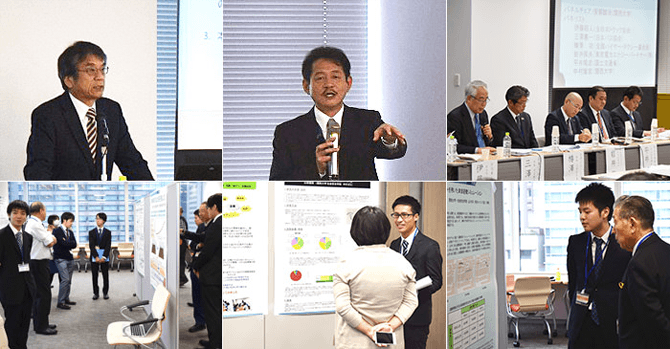
Date and time: November 11, 2016
Place: Kansai University Tokyo Center
The theme this year: "Future Traffic Society and Accident Prevention - Thinking About Safety of Bus, Taxi, Truck, and Commercial Vehicles - ". It was a valuable symposium where the industry leaders gathered together due to the consciousness of the problem that preventing the occurrence of traffic accidents and promoting the reduction of damage is one of the most important tasks for creating a safe and secure society.
The symposium was organized in two parts, and first of all in Part 1, Professor Seiji Abe, Dean of the Faculty, delivered a keynote talk titled "Issues in Securing Safety of Bus, Taxi and Truck Operations".
Next, talks were given on the human factors in traffic accidents, reliability and safety of machinery and systems, first by Professor Takahiro Nakamura of the Faculty titled "Human Factors and Traffic Accident Prevention", and secondly by Professor Toshiyuki Inagaki, Vice President and professor of Graduate School of Systems and Information Engineering, University of Tsukuba titled "Driver Assist Technology of the Automobile Has Come This Far - The Future and Safety of Automatic Driving -".
In the 2nd part, a panel discussion was held by panelists comprised of industry and administrative safety personnel and the speakers from Part 1. Panelists included the following persons and discussed the problems of each industry and the safety measures currently being implemented: Mr. Akihito Ito, Vice Chairman of the Japan Trucking Association, Chairman of the Traffic Control Committee; Mr. Kenichi Misawa, director of the National Bus Traffic Association, Chairman of the Safety Transport Committee; Mr. Isao Tarusawa, Director of Japan Federation of Hire-Taxi Associations, Chairman of the Traffic Safety Commission ; Mr. Yasuo Iwai, TEPCO Energy Partner, Inc., Safety Quality Manager; and Mr. Takashi Hirai of Department Chief of the Engineering and Safety Department, the Ministry of Land, Infrastructure and Transport, Road Transport Bureau.
More than 150 industry stakeholders participated in this symposium and were listening intensively to the discussion that was drawn out from multilateral perspectives.
In another venue, a panel of undergraduate research presentations was held by students. The results obtained from the researches were presented to the participants in this panel which the symposium visitors came to see on site. It was a great opportunity for students to take advantage of the chance to present the results of the issues they are working on day by day and they were able to receive advice based on practical experience from the participants, and have a fulfilling experience.
※ Stated affiliation and titles are as they were at the time of the event.
The 6th Symposium in Tokyo
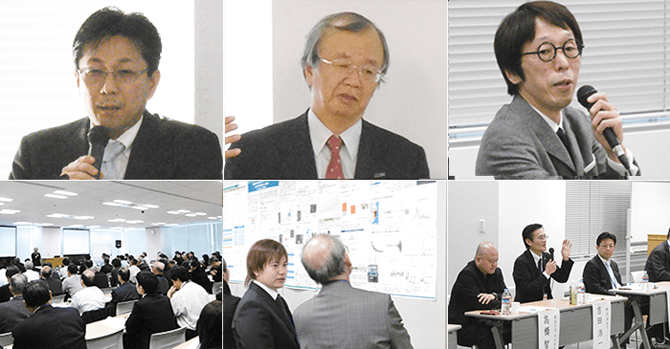
Date and time: December 11, 2015
Place: Kansai University Tokyo Center
The 6th Tokyo Symposium was held on the theme of "How to promote ‘Strengthening of Corporations and Organizations’ - the future vision for a disaster-reduced society". On that day, due to the influence of a developing low atmospheric pressure, the weather turned bad, but despite the situation, about 150 people came together, and it was able to proceed successfully.
In the present symposium, in order to truly realize "toughening", which tends to usually be understood as a discussion on the hardware side, such as expansion and enhancement of infrastructure, we focused on the "toughening" measures on the soft side as the central theme.
First, Professor Yoshiaki Kawata of the Faculty delivered a keynote lecture titled "Where is the blind spot of the metropolitan area? How should corporations behave now?" to raise questions on the countermeasures against huge disasters in large cities. Subsequently, four lectures were given as follows. Faculty Professor Tomoyuki Takahashi gave a report titled, "Corporate disaster prevention in the future based on the tsunami damage caused by the Great East Japan Earthquake (2011)"; Mr. Koichi Yoshida of Lawson Co., Ltd. titled "Support and crisis management for Ibaraki / Tochigi in heavy rain disaster areas and BCP (Business Continuity Planning)"; Associate Professor Morihiro Murakami of Kogakuin University titled "Efforts for Disaster Prevention in Shinjuku Station Area"; and Mr. Toshio Ohba of Mitsubishi Estate Co., Ltd. titled "Strengthening medical relief systems through business collaboration in the event of disasters".
Finally, a panel discussion was held with Associate Professor Tomofumi Koyama of the faculty serving as chair. Although time was restricted, a lot of remarks from the floor were made, and it became clear that the interest of corporations and organizations in disaster countermeasures was high.
On the same day, a presentation of posters made by the undergraduate students of the Faculty of Societal Safety Sciences was also conducted simultaneously in a different venue, and we received many positive remarks such as "There were many interesting studies".
※ Stated affiliation and titles are as they were at the time of the event.
The 5th Symposium in Tokyo
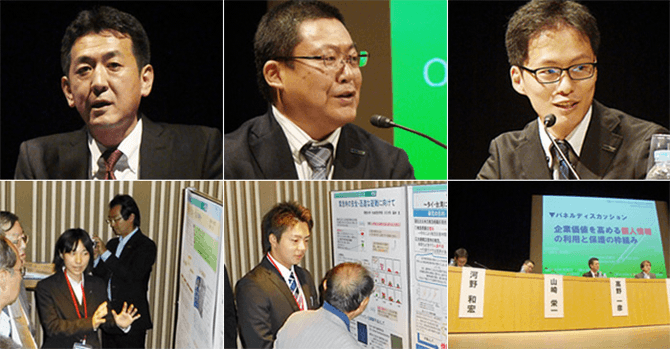
Date and time: Monday, October 20, 2014
Place: Nikkei Hall
Under the overall theme "Personal Information in the Era of Big Data - Utilization and Compliance of Data that Enhances Corporate Value -", the symposium was implemented in two parts: lectures by experts in each field, and panel discussions with experts active in corporations.
First of all in the lecture department of Part 1, Masao Horibe, Honorable Professor of Hitotsubashi University (Chairperson of Specific Personal Information Protection Committee) delivered a keynote lecture entitled "Utilization and Protection of Personal Data in the Big Data Era - Problem Presentation for Compliance with Corporate Laws, Disaster Prevention and ICT (Information and Communication Technology), etc." After that, proposals came for each field (company law, disaster prevention, ICT technology) in response to the problems raised by Honorable Professor Horibe, and lectures were given as follows: Kazuhiko Takano, Professor of the Faculty, titled "Usage and Protection of Personal Information in Enterprises", Eiichi Yamazaki, Associate Professor of the Faculty, titled "Usage and Protection of Personal Information in Disaster Prevention", and Kazuhiro Kono, Assistant Professor of the Faculty, titled "Technical Issues in the Use of Personal Information".
In the 2nd part, a panel discussion entitled "Framework of the Protection and Utilization of Personal Information that Enhances Corporate Values" was held by panelists, Keiji Sato, Hewlett-Packard Japan, Ltd., Koichi Yoshida, Lawson Co. Ltd., and the speakers at Part 1, with Seiji Abe, Professor of the Faculty as the moderator. Although there were time restrictions, vigorous discussions were held on various themes such as the criteria for judging the use of personal information, legal sanctions against the improper acquisition, and the ideal situation of third-party organizations handling information.
In another venue, research presentation from students by a panel was done, and the research results were reported by delegates. They were listened attentively to by many participants and were able to get valuable experiences that students can not usually get, such as exchanging opinions with people who are working at the frontlines.
※ Stated affiliation and titles are as they were at the time of the event.
The 4th Symposium in Tokyo
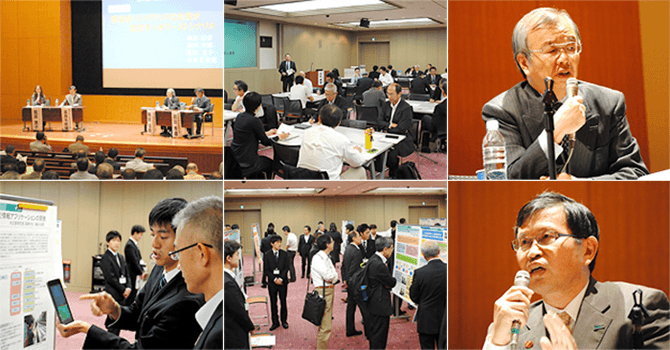
Date and time: October 28, 2013
Place: National Institute of Informatics, Tokyo (Hitotsubashi)
Overall theme: "How Should Corporations Confront "National Crises"? - Under the theme of "Massive Earthquake Disasters and Infectious Disease Pandemics" the programs were divided into three venues: "National Crises Session", "Practice in Crisis Management", and "Student Panel Presentations".
In Part 1 of the first venue of "National Crises Session", a panel discussion was held on the subject of "The Worst Scenario That Should be Assumed by Corporations Facing A Huge Earthquake Disaster" between the panelists Tetsuo Takashima, writer, and Yoshiaki Kawata, Professor of the Faculty, with Hiroko Aihara, an freelance journalist, as chairperson. In addition, in Part 2 of the first venue, under the theme of "The Worst Scenario That Should be Assumed by Corporations Facing An Infectious Disease Pandemic", a lively panel discussion was held about the way of thinking of infectious diseases and preparation for it, among three panelists Nobuhiko Okabe, Health and Safety Institute, Director of Kawasaki City, Hideo Maeda, Technical Supervisor of Tokyo Metropolitan Welfare and Health Bureau, and Toshio Takatorige, Professor of the Faculty, again with Hiroko Aihara, an freelancejournalist, as chairperson.
Also, as a fresh attempt, this time we set up a 2nd venue for "Practice in Crisis Management" to conduct participatory exercises such as "Charting Practice" and "Risk Communication Practice", in which there were many participants and it was well received.
In the first part, "Map Exercise" held by Shingo Nagamatsu, Associate Professor of the faculty, group work and presentations were done on the theme of "Crisis Management". In the second part, "Risk Communication Exercises", held by Yukio Hirose, Professor of the Faculty, participatory exercises were conducted, where a role play game in the negotiation of "acceptance of earthquake disaster debris" between an "Administrative role" and a "Resident role".
In the 3rd venue of "Student Panel Presentations", representatives and volunteers of undergraduates reported their continued day to day research results. Many participants showed interest, and for students it was possible to exchange opinions and was a valuable experience.
※ Stated affiliation and titles are as they were at the time of the event.
The 3rd Symposium in Tokyo
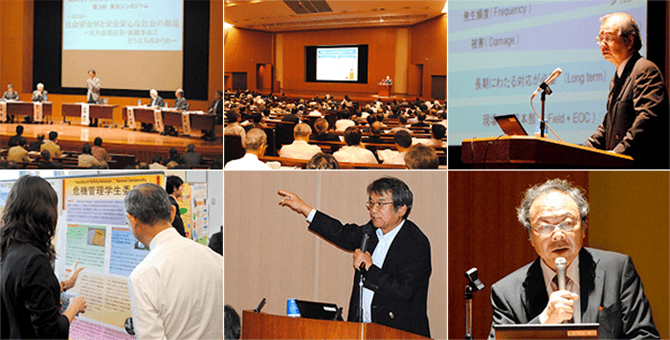
Date and time: October 16, 2012
Place: National Institute of Informatics, Tokyo (Hitotsubashi)
An exploration of "Practical Crisis Management" was pursued from the "Societal Safety Science" perspective of interdisciplinary research by combining the liberal arts and the sciences on natural disasters / social disasters under the overall theme of "Crisis Management and Social Safety for the Future of Corporations / Governmental administrations".
The symposium was organized in three parts, and in the 1st part, Yoshiaki Kawata, Professor of the Faculty and Director of the Societal Safety Research Center of the University, delivered a keynote lecture on "The earthquakes that directly hits Tokyo area as a Social Challenge".
In the 2nd Part, in response to the keynote lecture by Professor Kawata of Part 1, discussions were held according to themes of "The Challenge of Huge Natural Disasters and Social Safety (first venue)" and "Scandals of Businesses / Administration and Societal Safety Sciences (second venue)". In each venue, top-level guest members were introduced, reports were given by each member, and question-and-answer sessions were held, such as: At the 1st venue, Mamoru Ozawa, Dean and Professor of the Faculty, Yohtaro Hatamura, Emeritus Professor of the University of Tokyo, Director general of the Hatamura Institute for the Advancement of Technology, and Noboru Yamazaki, NHK reporter . At the 2nd venue, Seiji Abe, Professor of the Faculty, Mr. Noburo Gohara, Lawyer, Specially Appointed Professor of Kansai University Faculty of Societal Safety Sciences, and Kunio Yanagida, Nonfiction writer, visiting professor of Kansai University.
In the 3rd Part, under the theme of "Society Safety and the Creation of a Safe and Secure Society - How to Confront Huge Natural Disasters and Organization Accidents", a panel discussion was held among six panelists, Yotaro Hatamura, Kunio Yanagida, Noboru Yamazaki, Yoshiaki Kawata, Mamoru Ozawa, and Seiji Abe, with Yoshiyuki Yamazaki (NHK reporter) as the panel chair. In addition, the students’ poster sessions were held again, and we received positive opinions from participants that "not only research achievement of the Faculty of Societal Safety Sciences but also educational outcomes were conveyed well".
※ Stated affiliation and titles are as they were at the time of the event.
The 2nd Symposium in Tokyo

Date and time: October 28, 2011
Place: Japan Fire Defense Hall - Nissho Hall (Minato-ku, Tokyo)
Based on the Great East Japan Earthquake occuredon March 11, 2011 which caused unprecedented damage, under the overall theme "How to Draw-up The Worst-Case Scenario of earthquakes that directly hits Tokyo area - What Should be Learned From the Great East Japan Earthquake (2011) -" the experts inside and outside of the faculty examined the disasters which occurred in the Great East Japan Earthquake, and discussed various things about the worst case scenario if it takes place.
In the keynote lecture session of the 1st part, Yoshiaki Kawata, Dean and Professor of the Faculty, and Mamoru Ozawa, Deputy Dean and Professor of the Faculty, conducted recounting of the Great East Japan Earthquake. And in the 2nd Part, Itsuki Nakabayashi, Professor of Meiji University, Shingo Nagamatsu, Associate Professor of the Faculty, and Shozo Nagata, Associate Professor of the Faculty, each conducted a report on the expected "Worst Scenario" of a Metropolitan area earthquake.
Subsequently, a panel discussion was held by panelists consisting of all speakers from Part 1 and Part 2 on the overall theme and a question-and-answer session was implemented.
From the participants, many positive opinions such as "I learned a lot here, and I want to attend next year again" were obtained and the symposium was concluded on a high note.
※ Stated affiliation and titles are as they were at the time of the event.
The 1st Symposium in Tokyo
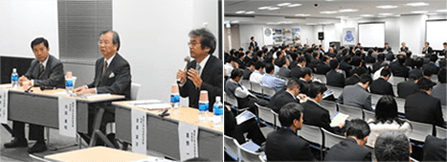
Date and time: December 16, 2010
Place: Kansai University Tokyo Center
Under the overall theme "Crisis in the Metropolitan Area Confronted by Enterprises - Disaster Response, Risk Management, and Compliance -", first of all, introduction of the Faculty and the Graduate School of Societal Safety Sciences was made by Mamoru Ozawa, Deputy Dean and Professor (at that time). Furthermore, a joint lecture on the "Corporate Disaster Prevention and Corporate Compliance" was delivered by three people: Yoshiaki Kawata, Dean and Professor of the Faculty, Kazuhiko Takano, Assistant Professor of the Faculty, and Noburo Gohara, Professor of Meijo University.
After that, a panel discussion was held on the whole theme, among four panelists, Noburo Gohara, Yoshiaki Kawata, Seiji Abe (Professor of the Faculty) and Kazuhiko Takano, placing Akihiko Nunomura (Visiting Professor of Kansai University) as Panel Chair. There were lively discussions on the countermeasures against various crises that could befall organizations.
In addition, Harishige Kusumi, President of Kansai University, also rushed from Osaka to this symposium and gave a salute to the participants in between the programs to express great thanks to the faculty. After the conclusion of the program, positive opinions were received from the participants in that the concept and expertise of the faculty was well understood, and it was a valuable opportunity for the Faculty of Societal Safety Sciences / Graduate School of Societal Safety Sciences that were newly established in April of that year.
※ Stated affiliation and titles are as they were at the time of the event.